Nina Notman reports on the international efforts to destroy Syria’s stockpiles of chemical agents
Toxic chemicals have been used in war for centuries, with the earliest archaeological evidence of their use dating from Roman times: around AD 256, dense clouds of choking gases formed from burning bitumen and sulfur crystals were used to kill 20?men, ironically in Syria. Chemical weapons technology has moved on somewhat since then and on 21 August 2013, after five apparent practice runs earlier in the year, an estimated 1500 Syrians, mainly civilians including many children, were killed by exposure to the nerve gas sarin in the eastern suburbs of Damascus.
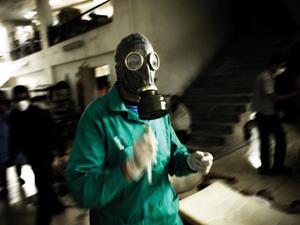
Syria has been embroiled in civil war since March 2011, with increasingly unpleasant tactics being employed by all sides. The US and a number of other countries have concluded that the Syrian government was responsible for the chemical weapon attacks, but Syrian president Bashar al-Assad maintains that opposition forces were responsible.
Following pressure from the international community, the Syrian government joined the Chemical Weapons Convention (CWC) and in doing so agreed to destroy its chemical weapon stockpiles. The CWC is a multilateral treaty that comprehensively bans chemical weapons, implemented by the Organisation for the Prohibition of Chemical Weapons (OPCW) based in the Hague, the Netherlands. The UN set a deadline of 30 June 2014 for destroying Syria’s chemical weapons.
Next, an achievable plan needed to be put in place. The CWC stipulates that countries must destroy their chemical weapons on their own territory, but it was rapidly decided this wasn’t feasible in this case. ‘The Syrian Arab Republic proposed that, based on resource limitations and the security situation within their territory, removing the chemicals for destruction outside of Syria was the most viable option available,’ explains OPCW science policy advisor Jonathan Forman. ‘OPCW member states agreed to provide assistance and the current destruction plan was subsequently drafted.’
The destruction plan
In September, the Syrian government declared approximately 1000 tonnes of chemical weapons, mostly precursors, and approximately 290 tonnes of raw materials. The blister agent sulfur mustard was the only complete – or unitary – chemical weapon declared. The nerve agents sarin, VX and VM are instead stockpiled by Syria in a binary manner, meaning two precursors are held and mixed just before use.
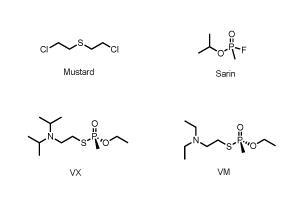
The plan is to chemically neutralise approximately 560 tonnes of the most dangerous chemicals – sulfur mustard and one of the sarin precursors (methylphosphonyl difluoride, better known as DF) – at sea aboard the US navy ship Cape Ray. Around 130 tonnes of an aqueous solution of a precursor to both VX and VM (sodium O -ethyl (methyl)thiophosphonate) are to be destroyed at a commercial incineration plant run by the waste management company Ekokem in Riihimñki, Finland.
Approximately 150 tonnes of the second precursors needed to make both VX and VM are to be destroyed at a commercial incinerator run by the environmental services company Veolia at Ellesmere Port in the UK. The VM precursor – diethylaminoethyl chloride hydrochloride– is in aqueous solution, while the VX precursor – diisopropylaminoethyl chloride hydrochloride– is in both a salt form and in aqueous solution.
It was decided to destroy around 120 tonnes of isopropanol, which can be mixed with DF to make sarin, in Syria. This is the only precursor being destroyed in the country and all of it has been verified as destroyed by the OPCW. The raw materials for these agents and precursors will also be incinerated: the organic chemicals at the Finnish incinerator and the inorganic compounds at another Veolia incinerator in Port Arthur, Texas, US.
The effluent from the Cape Ray hydrolysis operation will also be incinerated, but this step is not included in the June deadline. The DF effluent will go to the Finnish incinerator, while the effluent from the mustard hydrolysis will go to a German government run incinerator near Münster. This site is normally used to destroy old chemicals weapons discovered abandoned in Germany.
Making their escape
With the exception of isopropanol, the destruction plan requires the chemicals to be removed from Syria. They are transported overland in multiple batches from 12 storage sites to the port of Latakia. From there, chemicals bound for the Cape Ray and the UK are loaded onto the Danish civilian cargo ship Ark Futura, and the chemicals destined for Finland and US go on board the Norwegian civilian cargo ship Taiko. These ships are waiting in international waters, going to the port to collect each consignment before returning to international waters to await further batches.
The deadlines for both the removal of the chemicals from Syria and in-country destruction have passed and as Chemistry World goes to press the OPCW has confirmed that only 92.5% of the material has been removed or destroyed. All the mustard, however, is now on board the Ark Futura. The remaining 7.5% of material is at a single storage site that is currently inaccessible due to security concerns.
Once all of the chemicals are on board, the Taiko will sail to Finland and then the US, while the Ark Futura will sail to the Italian port of Gioia Tauro – where the mustard and DF containers will be trans-shipped to the Cape Ray – and then onto Marchwood Military Port near Southampton, UK. The Cape Ray is currently waiting at the port in Rota, Spain, and will time its arrival in Italy with that of the Ark Futura.
On board the Cape Ray
Before it left the US, the Cape Ray was kitted out below deck with two field-deployable hydrolysis systems. These were developed at Edgewood Chemical Biological Center in Maryland, the main US Army facility for chemical and biological defence R&D. The staff who work there – approximately 64 of whom are on board the Cape Ray – have extensive experience neutralising these two chemicals, gained through ongoing efforts to destroy the US chemical weapon stockpiles (see Chemistry World, July 2012, p42).
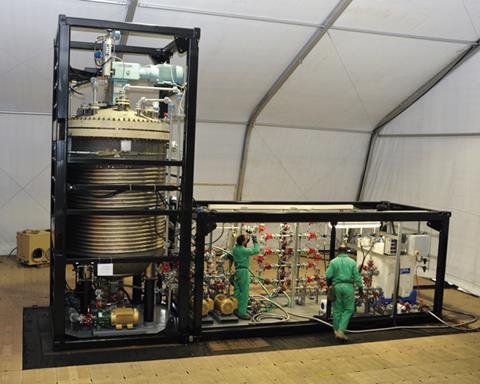
The units themselves, however, were only designed and constructed last summer. Their purpose was to assist with any future land-based chemical weapon destruction missions worldwide. It was not realised when they were constructed how soon they would be called into action. ‘While the technical approach – hydrolysis – has been used extensively for the destruction of chemical warfare material in the past, this particular platform has only been tested with surrogates,’ explains Timothy Blades, director of the hydrolysis operations on board the Cape Ray. Blades was also responsible for the design and fabrication of the hydrolysis units. Surrogates, or simulant materials, closely approximate the physical and chemical properties of their more toxic counterparts.
The decision to use the units at sea, rather than on land, was taken after no country agreed to the destruction of Syria’s mustard and DF on their territory, says Paul Walker, an expert on chemical weapons at Green Cross International. This non-government organisation has been working to promote the elimination of chemical weapon stockpiles worldwide since the early 1990s.
‘When the decision was made to deploy the equipment on a ship, extensive coordination with maritime experts was performed to ensure the equipment could safely and properly operate while the ship was underway,’ explains Blades.
Walker, however, says that unexpected issues may occur because the units are new and their set-up on ship unique, and they haven’t yet been tested on actual agents or precursors. ‘They have many kilometres of piping on board the ship, and the precursor chemical for sarin tends to crystallise and could back up and plug up the valves and the pipes. There could be breakdowns that would slow the process down,’ he says. The US government has predicted that the hydrolysis operation will take about 90 days. Blades remains confident: ‘The field-deployable hydrolysis unit was designed and built with an elegant simplicity and mechanical redundancy to address potential component failure. Should component repair or replacement be required, there are highly trained technicians as well as appropriate spare parts on board.’
The largest unknown is the weather. ‘There have been questions raised about what sea state they can operate in,’ says Walker. The Cape Ray is equipped with stabilisers, and because the ship has no set destination it can be navigated to avoid bad weather. Two sea trials have been carried out to evaluate safe operating parameters for both the equipment and the crew, says Blades.
The neutralisation process
The two field-deployable hydrolysis units are contained within a single environmentally sealed tent on board the ship. The plan is to operate the units in parallel 24 hours a day.
The mustard and DF will be neutralised slightly differently. ‘[Mustard] will be hydrolysed using a batch process facilitated by the titanium reactor at a ratio of approximately 13.5 parts 95°C water to one part ambient [mustard],’ explains Blades. The mustard breaks down in hot water to hydrochloric acid and thiodiglycol. The second step is to adjust the effluent’s pH to neutral using sodium hydroxide. ‘DF will be hydrolysed as a continuous feed process using a ratio of five parts ambient-temperature water to one part ambient-temperature DF,’ he says. DF breaks down to methyl phosphonic acid and hydrogen fluoride. A batch process using sodium hydroxide will again be used to adjust the pH. On board the ship there are approximately 220?ISO containers, each capable of holding 6600?gallons of water or caustic solution. The ship can desalinate additional water if required.
‘The neutralisation process generates hazardous waste effluent in volumes of five to 13.5 times the volume of chemical warfare material being treated. These materials are similar to standard industrial chemicals, containing less than 0.1% agent, that are regularly processed by commercial facilities,’ says Blades. This effluent will be stored in the empty ISO containers. After all the chemicals have been neutralised, the Cape Ray will sail to Germany and then Finland to deliver the two effluents for incineration.
Ellesmere Port
The main UK contribution is incineration of a VX and a VM precursor at Veolia in Ellesmere Port. These two precursors have civil uses, for example in the pharmaceutical industry, explains UK minister of state at the Foreign and Commonwealth Office Hugh Robertson. His portfolio includes the Middle East and counter-proliferation. ‘Veolia’s site destroys about 100,000 tonnes of industrial waste each year, so the chemicals from Syria will represent only 0.15% of the site’s annual input,’ he says.
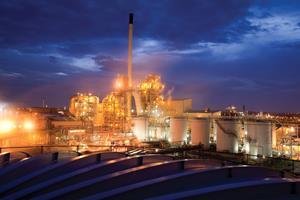
Veolia will oversee transport of the chemicals overland from Marchwood Military Port to its site at Ellesmere Port, explains the incinerator’s materials manager Ian Bowie. ‘We will bulk up the liquids in a small tank and then transfer them as a discrete batch into the incinerator,’ he says. The solids will be fed into the incinerator still packaged up. The empty plastic drums that contained the liquid will also be incinerated. The chemicals cannot all go into the incinerator together, as the calorific value of what is being burnt must be controlled to ensure emission limits are met. ‘We anticipate taking between two and four weeks to process the whole batch of materials,’ says Bowie.
Covering the costs
When a country joins the CWC it also agrees to pay for destroying its chemical weapons, and to cover the costs to the OPCW of verifying that the process has been done in accordance with CWC rules. ‘The Syrians have said that they are not able to pay for either the costs of destruction outside Syria or for the verification costs,’ explains an official from the UK’s Ministry of Defence who has been involved in planning the UK’s support for the destruction of Syrian chemical weapons. ‘The [OPCW] Director General set up trust funds to cover both sets of costs.’
The whole destruction program is costing at least a quarter of a billion dollars – maybe more
Paul Walker
Financial contributions have come from 30 different countries so far, and at the end of April 2014 the balance of the Syria trust fund for the destruction of chemical weapons had reached €47.5 million (£39 million) with an additional amount of nearly €3 million pledged. This isn’t a true indication of the cost of the operation, because many countries will be paying directly for much of the assistance they are personally providing.
The UK has ‘given £2 million to the OPCW to assist with its verification and destruction of Syria’s chemicals’, says Robertson. This does not include other costs, including the incineration activities at Ellesmere Port.
‘The whole destruction program, if you count all the in-time support, the naval facilities, the hydrolysis units, the Cape Ray, the OPCW inspectors, is costing at least a quarter of a billion dollars [£150 million] – maybe more,’ estimates Green Cross International’s Walker. ‘Syria is paying almost none of that.’
Ongoing concerns
The number of countries contributing may initially seem surprising, but it isn’t so much considering what a huge step this process is hoped to make towards a safer world. ‘It’s a really historic process,’ says Walker. ‘It is very important from a global security perspective.’ He suggests that Syria joining the CWC may encourage Israel and Egypt into the treaty regime. ‘Those are the three Middle Eastern countries that everyone has been worried about.’
Previously, countries that have signed the CWC have then adhered to the obligations outlined in the treaty – as far as we know. In Syria, however, that may not be the case. In April 2014, allegations began to surface about numerous suspected chlorine gas attacks in two rebel-held areas of Syria. Chlorine is a widely-used industrial chemical with peaceful purposes such as water treatment, but its use as a weapon contravenes the CWC. On 29 April, the OPCW announced that a team would soon be departing for Syria to establish the facts surrounding allegations of chlorine use in the country.
If it is proven that the Syrian government has violated the CWC, this breach would be dealt with at the international level by the OPCW and possibly referred to the UN. The ability to take legal action, however, relies on determining the perpetrator conclusively, something that was not done for last year’s sarin gas attacks. If it is confirmed that chlorine gas has been used as a chemical weapon in Syria, the world will be watching.
Nina Notman is a science writer based in Salisbury, UK
Deploying analytical chemistry
The OPCW is responsible for overseeing the entirety of this destruction operation, from verifying the packaging of the chemicals at the 12 storage facilities in Syria, through to ensuring the hydrolysis on board the Cape Ray is complete, and verifying the successful incineration of the other precursors and the hydrolysis effluent.
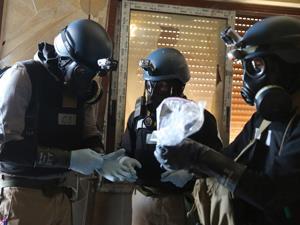
‘Many of the OPCW inspectors hold chemistry or chemical engineering degrees,’ says Jonathan Forman of the OPCW. ‘Their involvement in this operation ranges from physical and visual verification to performing GC–MS analysis on chemical samples.’ Gas chromatography–mass spectrometry ‘is the workhorse technique for analysing these types of chemical agents’, he says.
On the ground in Syria, however, the inspectors have also used mobile infrared and/or Raman devices. ‘IR or Raman spectroscopy can provide a chemical fingerprint to qualitatively confirm the presence of a specific chemical or type of chemical; these techniques are valuable for screening the identify of chemicals at storage sites or during transfer to destruction facilities,’ says Forman.
There is an analytical laboratory on board the Cape Ray containing GC–MS instruments. Before the hydrolysis begins ‘analytical chemists in this laboratory will verify the identity of the neat agent, ensuring the chain of custody at the point of destruction,’ explains Forman. ‘After neutralisation, GC–MS analysis would again be used, this time to determine that the neutralisation has gone to completion.’
The chemicals coming to the UK will also be tested on arrival at Marchwood Military Port, to verify their identity. ‘We intend to use Raman at the port to confirm the identity of the materials,’ says Veolia’s Ian Bowie. Unlike with chemical neutralisation, no testing is needed to verify complete destruction. ‘We operate at temperatures in excess of 1150°C,’ says Bowie. ‘Those sorts of temperatures are guaranteed to achieve complete thermal destruction.’
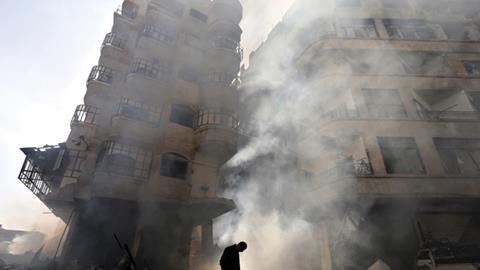

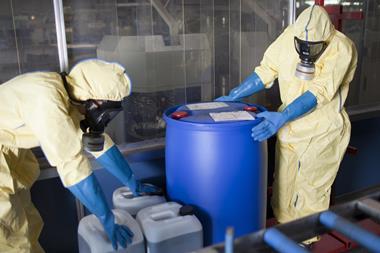
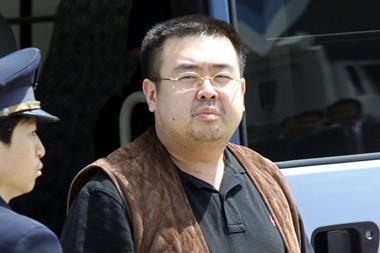
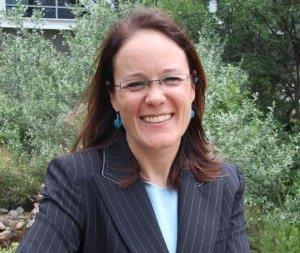
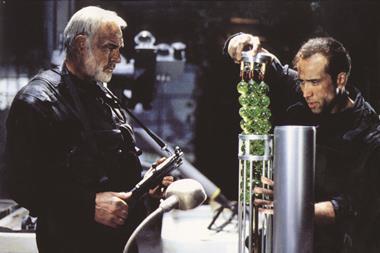







No comments yet